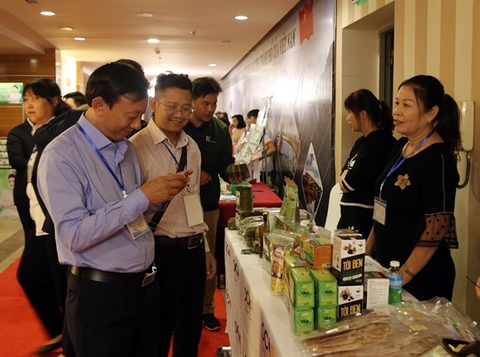
Delegates visit products exhibited at the sideline of the conference. — Photo baoquangninh.com.vn
China is a big market for Vietnamese agricultural, forestry and fishery products, but it also poses many barriers to imported products, requiring businesses to be keenly aware of market conditions, according to insiders.
They were speaking at a recent conference on agricultural, forestry and seafood exports to China in Mong Cai City in the northern province of Quang Ninh.
The conference was organised by the Ministry of Agriculture and Rural Development in collaboration with the People's Committee of the northern province of Quang Ninh within the framework of Viet Nam-China international trade and tourism fair 2019.
“China is a big market with a population of 1.4 billion people. Viet Nam is a neighbouring country with geographical advantages, so there are big opportunities for large import and export enterprises,” said Nguyen Quoc Toan, director of the Agricultural Products Processing and Market Development of Department under the Ministry of Agriculture and Rural Development.
“The Chinese market always appreciates the prospect and potential of development in trade of agricultural, forestry and fishery products of Viet Nam. However, recently, the number of Vietnamese agricultural and fishery products exported to China has dropped sharply,” he added.
China has been strengthening its management system and has certain requirements in terms of standards, traceability, packaging, labels and packaging, which has affected the exports of many enterprises.
Tran Van Cong, deputy director of the Agricultural Products Processing and Market Development of Department, said Vietnamese enterprises had to change their thoughts on production organisation.
“State management agencies from the central to local levels must also provide active support for businesses so Vietnamese goods can gain certifications, helping businesses have enough preparation to meet the Chinese market’s demand,” said Cong.
In recent years, bilateral trade turnover between Viet Nam and China has increased at an average rate of more than 20 per cent per year.
Two-way trade turnover reached US$108 billion last year and $94.5 billion in the first 10 months of this year.
China is consistently one of the largest importers for Vietnamese agricultural, forestry and aquatic products.
With its economic position, Quang Ninh had been a gateway of not only Viet Nam and other ASEAN countries with the Chinese market, but also the centre of the north-south corridor in the Greater Mekong Sub-region co-operation, said Bui Van Khang, vice chairman of the provincial People’s Committee, at the conference.
The value of import and export of goods through the province in recent years has increased at a high level. Import-export turnover hit $3.2 billion in the first 10 months of this year, up 10.3 per cent over the same period last year.
To promote cross-border activities, the province has improved transport infrastructure, as well as border gate systems.
Also at the conference, there was a signing ceremony of business co-operation between six pairs of Vietnamese and Chinese enterprises with total value of more than VND15 trillion ($644 million). — VNS